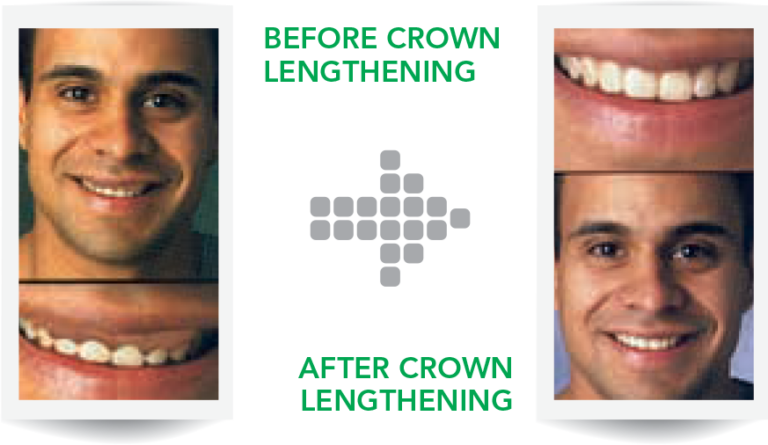Risks Involved With Crown Lengthening
As with all surgical procedures, there is a risk of prolonged bleeding during crown lengthening, as well as a risk of developing an infection after the procedure. Additionally, many patients will experience sensitivity to hot and cold because the roots of the teeth are now exposed. This will go away when the roots are covered with new temporary crowns. Because of the tissue and bone removal, the affected tooth may look longer than adjacent teeth. However, this is only a cosmetic consideration.
Removing bone from around a tooth can loosen it. In addition, if the tooth is ever lost, the removal of bone could reduce the chances of successfully placing a dental implant in that area. Your periodontist will consider these details during your consultation.
Your Patient Guide
Crown Lengthening
What Is Crown Lengthening?
Your dentist may have recommended a surgical procedure called crown lengthening. This dental treatment involves re-contouring the gum tissue and in some cases, the underlying bone that surrounds one or more teeth. It may be performed for functional or esthetic reasons.
Crown lengthening may be used to enhance a patient’s smile. For example, the procedure may be used to improve a “gummy” smile where teeth appear too short. The teeth may be the proper length, but too much gum tissue covers them.
In some cases, the gumline is uneven, which can make the teeth appear irregular. The dentist re-contours the gum and occasionally small areas of bone.

Crown lengthening may also be part of a treatment plan that uses crowns (also called caps) to optimize the patient’s appearance and comfort as well as the function of the teeth. In this instance, crown lengthening is used to expose an adequate amount of healthy tooth before the crown is placed. This helps prevent the crown from impinging on and irritating the gum tissues.
Crown lengthening may also be needed to make a restoration possible. If a tooth is badly worn or decayed, or has fractured below the gumline, or if there is not enough tooth present to support a restoration, crown lengthening may be recommended. The dentist adjusts the gum and bone level to expose more of the tooth so that it can be restored.
If one or more crown lengthenings are recommended, your dentist may provide the treatment or you may be referred to a periodontist, a dentist who specializes in the prevention, diagnosis and treatment of diseases of the tissues that support and surround the teeth.
Preparation
You will visit a periodontist for a consultation before the procedure. During the consultation, the specialist will review your medical history and your X-Rays, and set a date for the surgery. Your periodontist will instruct you on how to keep the area clean after the surgery. You may receive a tooth cleaning before the procedure.
If the tooth needs a crown, your periodontist may have a temporary crown put on the tooth to protect it. This also makes the crown-lengthening procedure easier because the tooth is already prepared for the crown, and the periodontist can see precisely how much soft tissue or bone will need to be removed. Once the area has healed completely — in about three months — your dentist will prepare the tooth again, and make a new temporary crown before making the final crown.
Contact Your Periodontists If:
- You have bleeding that doesn't stop
- You think the area might be infected
- The protective dressing becomes loose or is displaced
How Is It Done?
This procedure is done under local anesthesia.
The amount of time it takes varies depending on the number of teeth that require treatments. Although your problem may involve only one tooth, crown lengthening surgery typically includes neighbouring teeth so that the tissues can be reshaped gradually. If only soft tissue is removed, the procedure probably will take less time than if both soft tissue and bone are removed.
The periodontist will make incisions to “flap” the gums away from the teeth. This provides access to the roots of the teeth and the surrounding bone. In some cases, by simply removing a little gum tissue when the incisions are made, enough tooth structure will be exposed for your dentist to place a crown or filling. However, in most situations it will also be necessary for the periodontist to remove some bone from around the roots of the teeth.
Once the periodontist is satisfied that enough tooth structure is exposed, the surgical area will be washed with sterile salt water and the flaps will be stitched together. At this point, your teeth will look longer because the gums are now sitting at a lower level then before the surgery. Some periodontists use a periodontal dressing — called an intra-oral bandage — to cover the surgical site. Any temporary crowns will be removed before the procedure begins and replaced afterward.
You will be given prescriptions for pain medication and a chlorhexidine mouth rinse. Your periodontist will review oral-hygiene instructions, and ask you to follow a somewhat soft diet. You can brush the teeth in the area that was worked on, but you should avoid the gums and remove food particles around the affected teeth with a toothpick or a water irrigator.
Did You Know?
Sometimes a patient has a
“gummy” smile that hides the
beautiful teeth below the gums.
This procedure can be used to
shape the gums to create a
beautiful smile. .
What Our Patients Say?
We accept all major insurance plans.
We accept a number of insurance plans to help cover the cost depending on your individual needs.
